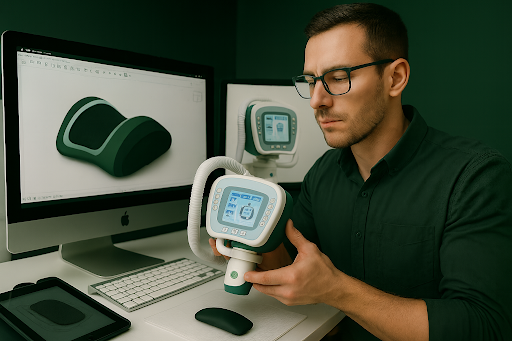What Is Rapid Prototyping? A Beginner’s Guide for Product Developers

In the ever-evolving world of product development, one concept has emerged as a game-changer for engineers, designers, and innovation managers: rapid prototyping.
Whether you’re designing a medical device, developing wearables, or working on industrial controls, the ability to quickly transform an idea into a tangible prototype can significantly accelerate the product development cycle. It can reduce costs, increase efficiency, and even influence product design in ways that traditional methods simply cannot.
But what exactly is rapid prototyping, and why does it matter in real-world industrial design and manufacturing? This guide will explore the ins and outs of rapid prototyping, its benefits, challenges, and its crucial role in modern product development.
From understanding the different technologies available to integrating prototypes into the product lifecycle, we’ll delve deep into how rapid prototyping is transforming the way products are developed, tested, and manufactured.
What Is Rapid Prototyping?
At its core, rapid prototyping is a set of techniques used to quickly fabricate a physical part or assembly using computer-aided design (CAD) data. Unlike traditional manufacturing methods, which can take weeks or months to create prototypes, rapid prototyping allows for fast, cost-effective creation of prototypes in a matter of hours or days.
Rapid prototyping involves various technologies, most notably 3D printing, but also includes CNC machining, injection molding, and other additive manufacturing techniques. The goal is to produce prototypes that allow designers and engineers to evaluate form, fit, and function in the early stages of development before committing to full-scale production.
For a deeper dive into how prototyping can streamline your development process, check out How Prototyping Can Improve the Product Journey.
Why Rapid Prototyping Matters for Product Developers
For industrial engineers and product designers, rapid prototyping is more than just a trend. It’s a practical tool that solves several common challenges in product development.
1. Faster Time to Market
Traditional prototyping methods often involve time-consuming steps, from tooling and machining to iterative testing. Rapid prototyping can streamline these processes, allowing product teams to create and test prototypes in days instead of weeks. This speed is critical in today’s competitive market, where getting a product to market faster can mean the difference between success and failure.
2. Reduced Development Costs
With rapid prototyping, you can create multiple iterations of a product at a fraction of the cost compared to traditional methods. Engineers can make design changes on the fly without worrying about expensive tooling and setup fees. This is especially valuable for projects with tight budgets or limited production runs.
3. Improved Product Quality
Early prototypes allow you to test functionality, ergonomics, and usability before you commit to production. This iterative process helps uncover design flaws, potential performance issues, or usability challenges that may have been overlooked in early design phases.
4. Collaboration and Communication
Prototypes make it easier for cross-functional teams, engineers, designers, marketing, and even customers to visualize the end product. A tangible prototype helps avoid miscommunication that often arises from conceptual or digital designs, making collaboration more effective.
Types of Rapid Prototyping Technologies
The success of rapid prototyping hinges largely on the choice of technology. Each method has its strengths and weaknesses, and the decision of which one to use depends on your project’s specific requirements.
1. 3D Printing (Additive Manufacturing)
3D printing is arguably the most well-known and widely used rapid prototyping technology. It creates physical objects by building them layer by layer from a digital model. The process of additive manufacturing is ideal for creating complex geometries that would be difficult or impossible to achieve with traditional methods.
- Use cases: Aerospace components, wearable designs, automotive interior parts.
- Pros: Fast, cost-effective for low-volume runs, able to handle complex geometries.
- Cons: Limited material options (compared to traditional manufacturing), surface finish may not be as polished.
2. CNC Machining
CNC (Computer Numerical Control) machining involves using computerized tools to cut and shape material into the desired form. While slower than 3D printing, it can produce parts from a wide variety of materials with high precision.
- Use cases: Automotive components, industrial tools, medical device prototypes.
- Pros: High accuracy, better material variety, stronger parts.
- Cons: Longer lead times, higher setup costs compared to 3D printing.
3. Injection Molding (Rapid Tooling)
Injection molding is often used for creating high-volume plastic parts, and rapid tooling is an extension of this process that allows you to create molds quickly for prototyping. Rapid tooling uses softer, less expensive materials to create molds, making it faster and cheaper than traditional injection molding.
- Use cases: Consumer products, packaging, and medical device housings.
- Pros: High-quality finish, allows for production-level quantities.
- Cons: Still more expensive and time-consuming than other rapid prototyping methods for small quantities.
4. Stereolithography (SLA) and Selective Laser Sintering (SLS)
SLA and SLS are forms of 3D printing that use lasers to cure liquid resin (SLA) or sinter powdered material (SLS) layer by layer. These methods provide high precision and a better surface finish than traditional 3D printing techniques.
- Use cases: Medical device prototypes, jewelry, and aerospace parts.
- Pros: Excellent detail, high strength-to-weight ratio.
- Cons: Limited material options, higher costs for large-scale parts.
Real-World Applications of Rapid Prototyping
To understand why rapid prototyping matters, let’s take a look at some real-world examples where rapid prototyping has made a significant impact.
- Medical Devices
The medical industry has seen substantial benefits from rapid prototyping. Medical device manufacturers often use it to quickly develop and test new instruments or implantable medical devices. For instance, prototypes of surgical tools can be tested in real-world conditions to ensure they’re ergonomic, functional, and compliant with stringent regulations such as FDA standards. Rapid prototyping helps reduce the time it takes to bring life-saving innovations to market.
2. Wearables and Consumer Electronics
In the wearables industry, rapid prototyping is essential for creating devices that are lightweight, comfortable, and durable. Product developers rely on 3D printing to iterate on design aspects such as the enclosure, buttons, and internal components. This allows for quick user testing and optimization before mass production begins.
3. Automotive and Aerospace
In the automotive and aerospace industries, where precision and durability are paramount, rapid prototyping enables engineers to test complex, custom parts before production. For example, aircraft manufacturers use rapid prototyping to create and evaluate interior cabin components, while automotive engineers use it for prototyping dashboards or lightweight structural components.
Challenges and Considerations in Rapid Prototyping
While rapid prototyping offers significant advantages, it is not without its challenges. Here are some key considerations that product developers should keep in mind:
1. Material Limitations
Depending on the prototyping method, material options can be limited. For example, 3D printed prototypes may not offer the same strength, flexibility, or heat resistance as the final product made with traditional manufacturing methods. Ensuring that the prototype is made from materials that closely mimic the final product’s characteristics is critical for accurate testing.
2. Durability and Testing
Prototypes are often used for form and fit testing, but durability testing should not be overlooked. For products that will undergo significant wear and tear—such as automotive parts or military equipment—it’s important to simulate real-world conditions, including mechanical stresses, environmental factors, and regulatory standards.
3. Compliance and Certification
Certain products, especially those in industries like medical devices or military equipment, must adhere to strict compliance standards (e.g., FDA approval, MIL-specs). Rapid prototyping is a useful tool for iterating on designs quickly, but it’s essential to consider how the final product will meet these rigorous requirements, which may necessitate additional testing or certification.
Conclusion
Rapid prototyping has revolutionized the product development landscape, offering significant benefits in terms of speed, cost, and design flexibility. Whether you’re working on wearables, medical devices, or industrial equipment, the ability to quickly iterate and refine your designs can give you a competitive edge in the marketplace. While there are trade-offs to consider, such as material limitations, testing requirements, and compliance, the power of rapid prototyping to bring ideas to life faster and more efficiently cannot be overstated.
By embracing rapid prototyping, engineers and product developers can not only reduce the time and cost of bringing products to market but also ensure that their products meet the high standards of performance, usability, and compliance that today’s industries demand.

Business Checking Account Options for Modern Entrepreneurs

Why Businesses Require Inspection of an LPG Tank

Cost of Private 5G and Private LTE Networks: What Should Businesses Choose

Accelerating drug discovery through the DEL-ML-CS approach

AI in Marketing Is No Longer a Buzzword — It’s the Strategy

Unlock Your Music: How to Download Apple Music to MP3 with ViWizard

Top 10 Mobile App Development Companies in Dallas to Watch in 2026









